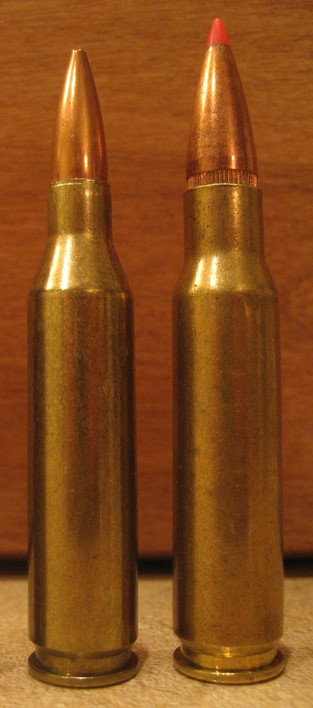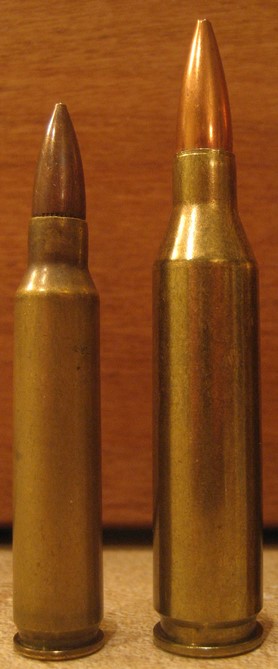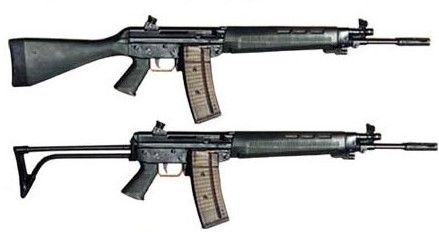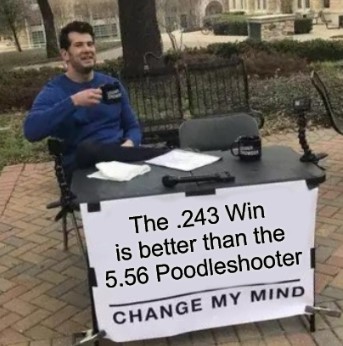I was sucked into the Forgotten Weapons Matrix a little while ago, and during Ian McCollum’s dissertation on the Sig-Manhurin 542 rifle, my train of thought went off down a branch line — I’m an old guy, it happens — and I ended up wondering: why was the .243 Win never adopted as a military cartridge?
(In the interests of full disclosure, I should point out here that I am a HUGE fan of the .243 Win, especially when loaded with a 90gr bullet.)
Run with me on this one. The .243 Win is based on a necked-down .308 Win casing so that it can shoot a smaller 6mm (.243″) bullet. Here’s the side-by-side comparison:

That’s a lot of powder (assuming that it stays the same amount as in a .308 Win cartridge) to send a much-smaller bullet downrange, which means of course that there’s a lot of velocity involved — and, as a welcome side-benefit, because there’s less inertia to overcome to get a smaller bullet moving than a bigger one, less recoil.
The latter was given as being one of the reasons that the 5.56mm NATO was adopted, by the way (that and the reduced weight of the cartridges themselves), but it came at the expense of knockdown power. Also of interest is that the 5.56 NATO generally uses a 55gr bullet — but, for that matter, the .243 can handle a 55gr bullet as well, and it really races out of the barrel. Once again, a comparison:

The only problem with the 5.56 NATO is that if you try to increase the knockdown power of the poodleshooter by shooting a heavier bullet like (say) one of 90gr, that little casing can’t hold more powder to make up for the severe loss in velocity — whereas in a larger casing like the .308 Win, bullet weight could even be doubled to 110gr without too much effect on velocity, or recoil.
So just as an intellectual question, I ask myself: why would the .dotmil settle for a hot .22 cartridge when a downloaded .308 would do the same job (at worst), and could easily do a lot more with only a modest increase in bullet weight (say, from 55gr to 75gr)?
If we accept the fact that the earlier .30-06/.308 Win battle cartridges were just Too Much Muscle (or required too much muscle) for our soldiers (as suggested by the military brass), and we ended up adopting a vastly inferior cartridge (the poodleshooter .223); then why should we not have compromised and used instead a 6x52mm / .243 Win cartridge? (Of course, I am still of the opinion that the British suggestion of a .276″/6.5mm chambering was the best of all, but let’s not revisit that old story.)
Frankly, I think we missed a good opportunity here, and I think that had we adopted the .243 Win chambering in something like the aforementioned SIG-Manhurin 542 (essentially, a higher-quality AK-47 design) as our mail battle rifle, we would have been a lot better off.

For that matter, the AR-10 (suitably barreled) would have been just as good a choice, if the thought of dumping Eugene Stoner’s rifle for Sergei Kalashnikov’s gives one the vapors.

Either way, the question is this:


Or they could have just gone with a .270, with a lightweight bullet at 3600 feet per second…
But that would have obviated the need for the M-14, as a .270 would just require a re-barreled Garand.
A .243 AR-10 would have been tits.
A couple things here:
Thing the Zeroth: I have no special love, nor hate for the 5.56, just as I have no particular emotion about a bandsaw or a pipe wrench. No one tool does it all, and one should realize the niche and purpose of the tool, and where it works well.
Thing the first: Military planners at the time were of the belief that if you *wounded* one enemy soldier you took *at least* four people off the battlefield (number may vary depending on source), whereas a kill only took 2 people off the field, one very temporarily. Thus all that matters is that you can wound them enough to get them to stop fighting. The 5.56 in a 55 grain bullet is *adequate* for that.
Thing the second: There was a LOT of politics, as you know. We went from 30.06 to .308 because of pigheaded generals who hadn’t humped a real rifle for more than a few hours at a time in years to decades, and who felt that 800 yard performance mattered more than logistics. I’m all for training troops to get accurate fire at 500 yards (after all I am a former marine), but in “real world” conditions that sort of range is for snipers and designated marksman, while the rest of the platoon supports them. Anyway, we tried to force .308 on NATO, and it sorta worked. Then we realized a smaller round would be better.
Thing the third: Logistics. The .243 is, at one layer of analysis, is the WORST compromise between the .308 and a smaller round. It is (logistically) the same size–meaning you can’t carry any more–and not significantly lighter. At the same time it’s significantly smaller a *bullet* which means penetration isn’t up to the .308 levels.
Thing the third (a): Logistics again, more powder means faster bullet, faster bullet means more more barrel wear, and more wear on other parts. I’ve fired a M16 with well over 100k rounds through it. It was as loose as this actress I dated, but it still went bang when I fingered it (like this actress I dated…). More wear means more replacement parts.
The 5.56 is kinda like the 9mm. It is neither as bad as it’s detractors (mostly older folks who remember the past through certain filters), nor as good as it’s proponents.
What neither of them realize is that in the context of modern combined arms actions *it doesn’t matter what the caliber of the rifle is*. It has to be reliable, it has to be accurate, but the modern battlefield is a REALLY wide range of things from close in urban combat to desert mountains, jungles, etc. and NO RIFLE OR CARTRIDGE IS GOOD FOR ALL OF THEM.
This is why we have a handful of “riflemen” with M203s who support, and are supported by squad automatic weapons, medium machinegun teams, mortars, Field F*king Artillery, CAS and in-extremis heavy bombers. You have Corporals on radios telling O3s in airplanes where to put their loads.
When you move from desert/plains into town or city *everything* changes. No longer does your ability to hit at 800 meters matter because *you can’t see that far*. What matters is how fast you can get in and out of vehicle, how well you can around a stairwell and how *precise* can you make that shot so you don’t miss and put a round through a wall 200 yards away with a couple kids hiding behind it.
Frankly I think the answer is to develop better expanding (but non-fragmenting) bullets.
Excellent all the way around, and I agree. I’m ex-army ahd have 100k rounds through an M16 as well and built an AR15 3 years ago. I pretty much like all guns and understand the tool must fit the job.
I don’t think I have 100k rounds through an M16 platform–the M16 that I was qualifying on was an A1 that had been “upgraded” to an A2 at some point, and I was shooting it in 2006 IIRC.
In addition to my Marine Corps experience I have some time in the Army National Guard and the Air Force Reserves (if I could get the Coast Guard to take me I’d have the whole set…), and I spent some time in Iraq as a DoD contractor (IT, not shooter).
My last range day was spent getting a “battle sight zero” on 2 firearms (AR 15 with traditional scope, Sig556 with reflex sight) and confirming/adjusting the zero on my AK with an old Aimpoint. Oh, and I had the PTR91 out just for fun.
Frankly the trigger on the AR was MUCH better than anything else. But I *DETEST* hearing/feeling the spring in the buffer tube. HATE IT.
The PTR though…you really know you’d shot something when you touched it off. Mans rifle that is.
(if I could get the Coast Guard to take me I’d have the whole set…)
Well, if you’re a “boater”, there’s always the CGAux – but they make you buy your uni and equipment.
Moreso than the generals, it was a single Colonel, one Rene Studler, the Chief of Small Arms for the Ordnance Board, who forced the Army ( and thus NATO) into the 7.62×51, and subsequently the M-14.
The Infantry Board really liked the EM-2 in the Brit .280, but Studler overruled them.
My old hunting buddy used to go deer hunting with his wife occasionally.
She was a crack shot with her .243, which had weight and recoil she could handle. She tried bigger cartridges and rifles, up to a .30-06 but they were unpleasant for her, she was not a large woman.
The military is looking at the 6mm ARC now. It is based on the 6.5mm Grendel cartridge, with even less drop at long range with a lighter weight bullet. All of these are a fit for the AR15 platform as opposed to the larger and heavier AR10 platform needed for the .308 or 6.5 Creedmoor. If I remember right, it’s not quite up to 243 ballistics because of the smaller case, but reasonably close. So logistically in the middle, better range and lethality than the 5.56, and comes at the cost of introducing new and different into the supply chain. Better ballistics and lethality, yes. Worth it? That depends. In Afghanistan, for the range alone, yes. Worth changing the entire supply chain and leaving our allies with incompatible weapons? Nothing I’m qualified to answer.
There are always tradeoffs.
I suspect anything based off the 7.62×39 case is going to be a nonstarter in the AR-15 platform without significantly upgrading the bolt material. Aermet 100 works, but you’ll wind up jacking up the price of the rifle by at least a third.
Very interesting post. It makes me want to try out the .243, but I probably won’t for the same reason that I don’t have any 5.56 on the premises … logistics. The handful of serious rifles hereabouts are all in 7.62×51. Furthermore, the ammo locker contains 80% or more of only one major type as well (175gr SMK, if you must know). More of one thing versus less of a bunch of different things. Seems sensible to me.
I used my dad’s 243 as a deer rifle when I was in high school in the 70’s. I graduated to 30-06 in my early 20’s. The 243 could get the job done but it needed a little more knock down power. I have built my ideal version of an AR with 6.8SPC. It is a 270 light and the ideal bullet weight for a 300 to 600 yard shot is 115gr. I can go with a heavier bullet but max effective range drops quickly.
Sigh. So if the .30 cal is so grand and the .22 cal so awful, subsequent to the Viet Nam war the Soviets patted themselves on the back… Oh, wait.
Jokes aside, they extensively tested pretty much every caliber between 5 and 7 mm. I’m now wondering if those test results are available online; worth translating if nobody’s done so yet. But seriously, the fact that they wound up settling for a .22 cal carbine cartridge, admittedly with a much better bullet then anything we came up with in the previous century, hints that maybe .mil isn’t completely stupid.
McCollum.
I have a question – .243 of an inch does not convert precisely to 6 mm ( I know, the difference is only approximately 2%). So does the 3 figure precision of .243 imply the original “precise” specification for the round, and that 6 mm is only an approximation for info, or does it actually mean that the 2% difference is no big deal and that a 6 mm round will work as well (cartridge permitting), or will something blow up?
Springfield Armory had a .243 version of the M1A, DPMS can and others had versions of AR10 in .243, really only a rebarrel job. Bolt, magazine, the same as .308.
Given political climate and current ammunition available might be prudent to pursue. Ammunition available even at Walmart.
As you noted cartridge adequate for varmints to Goblins, with less recoil and great accuracy.
I carried both M4 and SAW in the USMC (M16 in boot doesn’t count). Wasn’t an 03, but shot both of them plenty. Them’s my bonafides.
That being said, why would I want a rifle chambered in a rnd that’s ballistically inferior to a .30 cal, but identical in capacity? I’m a firm believer of no kill like overkill, and anything worth shooting is worth shooting a bunch of times. I want as many chances to hit what I’m shooting at in a dynamic environment as possible.